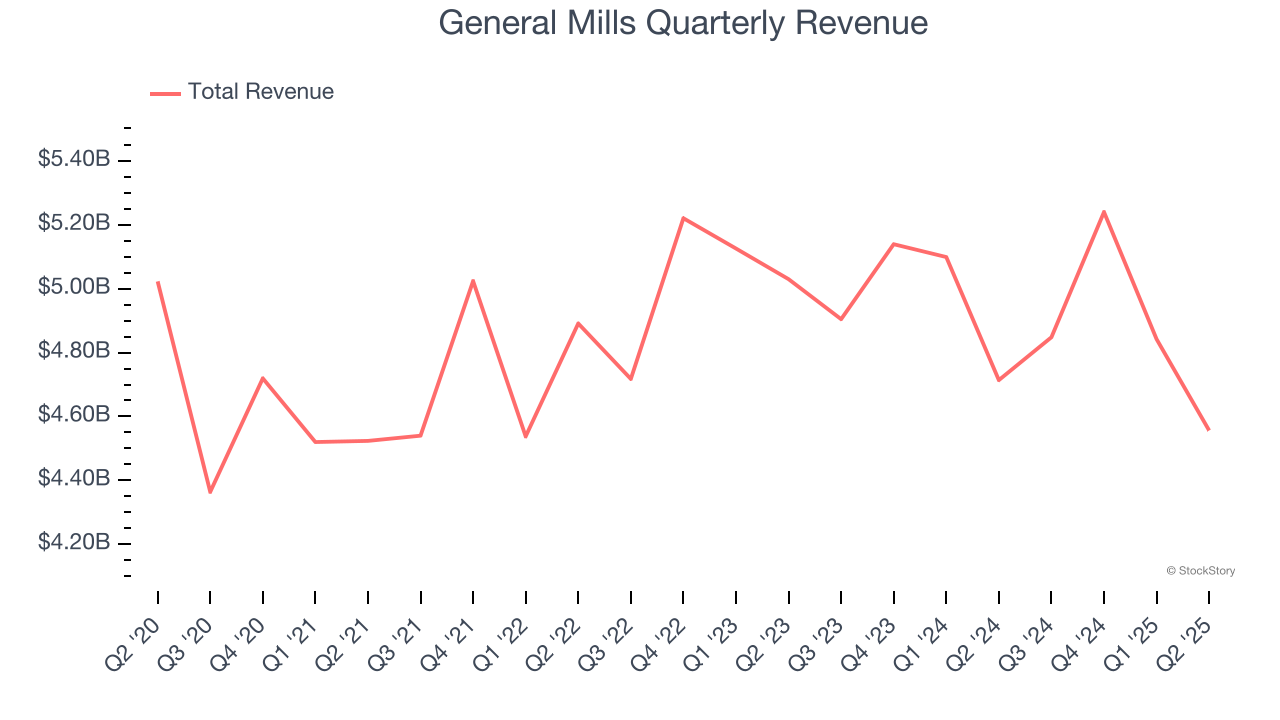
Packaged foods company General Mills (NYSE: GIS) fell short of the market’s revenue expectations in Q2 CY2025, with sales falling 3.3% year on year to $4.56 billion. Its GAAP profit of $0.53 per share was 26.1% below analysts’ consensus estimates.
Is now the time to buy General Mills? Find out by accessing our full research report, it’s free.
General Mills (GIS) Q2 CY2025 Highlights:
- Revenue: $4.56 billion vs analyst estimates of $4.58 billion (3.3% year-on-year decline, 0.5% miss)
- EPS (GAAP): $0.53 vs analyst expectations of $0.72 (26.1% miss)
- Adjusted EBITDA: $639.6 million vs analyst estimates of $749.6 million (14% margin, 14.7% miss)
- Operating Margin: 11.1%, down from 16.5% in the same quarter last year
- Free Cash Flow Margin: 8.6%, down from 12.2% in the same quarter last year
- Organic Revenue fell 3% year on year (-6% in the same quarter last year)
- Sales Volumes fell 2% year on year, in line with the same quarter last year
- Market Capitalization: $29.25 billion
“The investments we made in the second half of fiscal 2025 to bring consumers more value worked as we expected, driving improved volume and pound share trends in the fourth quarter,” said General Mills Chairman and Chief Executive Officer Jeff Harmening.
Company Overview
Best known for its portfolio of powerhouse breakfast cereal brands, General Mills (NYSE: GIS) is a packaged foods company that has also made a mark in cereals, baking products, and snacks.
Revenue Growth
Reviewing a company’s long-term sales performance reveals insights into its quality. Any business can have short-term success, but a top-tier one grows for years.
With $19.49 billion in revenue over the past 12 months, General Mills is larger than most consumer staples companies and benefits from economies of scale, enabling it to gain more leverage on its fixed costs than smaller competitors. Its size also gives it negotiating leverage with distributors, allowing its products to reach more shelves. However, its scale is a double-edged sword because it’s harder to find incremental growth when your existing brands have penetrated most of the market. For General Mills to boost its sales, it likely needs to adjust its prices, launch new offerings, or lean into foreign markets.
As you can see below, General Mills struggled to increase demand as its $19.49 billion of sales for the trailing 12 months was close to its revenue three years ago. This is mainly because consumers bought less of its products - we’ll explore what this means in the "Volume Growth" section.

This quarter, General Mills missed Wall Street’s estimates and reported a rather uninspiring 3.3% year-on-year revenue decline, generating $4.56 billion of revenue.
Looking ahead, sell-side analysts expect revenue to decline by 3.3% over the next 12 months, a deceleration versus the last three years. This projection doesn't excite us and suggests its products will see some demand headwinds.
Unless you’ve been living under a rock, it should be obvious by now that generative AI is going to have a huge impact on how large corporations do business. While Nvidia and AMD are trading close to all-time highs, we prefer a lesser-known (but still profitable) stock benefiting from the rise of AI. Click here to access our free report one of our favorites growth stories.
Volume Growth
Revenue growth can be broken down into changes in price and volume (the number of units sold). While both are important, volume is the lifeblood of a successful staples business as there’s a ceiling to what consumers will pay for everyday goods; they can always trade down to non-branded products if the branded versions are too expensive.
To analyze whether General Mills generated its growth (or lack thereof) from changes in price or volume, we can compare its volume growth to its organic revenue growth, which excludes non-fundamental impacts on company financials like mergers and currency fluctuations.
Over the last two years, General Mills’s average quarterly volumes have shrunk by 1.6%. This isn’t ideal for a consumer staples company, where demand is typically stable. In the context of its 1.6% average organic sales declines, we can see that most of the company’s losses have come from fewer customers purchasing its products.

In General Mills’s Q2 2025, sales volumes dropped 2% year on year. This result represents a further deceleration from its historical levels, showing the business is struggling to move its products.
Key Takeaways from General Mills’s Q2 Results
We struggled to find many positives in these results as its revenue, EPS, and EBITDA fell short of Wall Street’s estimates. Overall, this was a softer quarter. The stock remained flat at $53 immediately after reporting.
General Mills’s earnings report left more to be desired. Let’s look forward to see if this quarter has created an opportunity to buy the stock. If you’re making that decision, you should consider the bigger picture of valuation, business qualities, as well as the latest earnings. We cover that in our actionable full research report which you can read here, it’s free.




